- Home
- Peripherals
- Microphones for Gaming
Microphones for Gaming in 2026 – Hear The Difference!
Updated: September 12,2023
Picture the scene. You’re knee-deep in mud, blood, and grime. Desperately clutching your rifle with sweaty palms as you focus your attention on the nearby ridge. Trying not to make a sound, as you slowly creep towards the enemy, hoping not to get spotted. Your entire team is dead, and now it’s all up to you. Suddenly, a screeching background noise gives away your position, and you’re biting the dirt. Game over.
You forgot to feed your cat, and he has turned the tide of war again. If this sounds familiar to you, then you’ve probably experienced the bad mic blues before. If so, join us on our quest as we explore the best microphones for gaming you can find in 2026. They may not help you deal with those noisy neighbors or your overly excitable pet, but at least they’ll minimize such artistic contributions and make you sound better on the internet.
HyperX QuadCast



- Excellent sound for price
- Intuitive setup
- Four polar patterns
- Picks up some ambient sounds
The story of HyperX, Kingston’s high-performance product division, started in 2012. Originally a manufacturer of enthusiast RAM modules, HyperX has since expanded into many gaming peripherals, including headsets and microphones.
QuadCast is the company’s first serious foray into professional streaming microphones. It’s definitely one of the best streaming microphone options on the market in this price range.
Compared to the traditional black or gray monochrome recording mics, QuadCast features a traditional black-and-red HyperX color scheme, which definitely stands out, for better or for worse. The mic supports four polar patterns easily switchable by turning a knob at the front and a very handy touch-sensitive mute sensor on the top. There is also a built-in anti-vibration shock mount, which helps prevent accidental bumps from being picked up while streaming. It’s definitely a great feature at this price range, considering that aftermarket shock mounts retail for anywhere between $10 and $100, with other mics of comparable quality costing upwards of $50.
But the best USB microphones for gaming and streaming need to have more than several polar pattern options and a good shock absorber.
If we were to level one complaint at QuadCast, it would be that its background noise filtering could use some improvements. While we had no trouble with the shock mount, the mic did catch some ambient noise in our tests. Furthermore, the included stand is a bit short if you’re going to be speaking closely into the mic, which is a shame as it tends to sound best that way. It does mean, though, that the mic has a fairly small footprint on your desk, despite being longer than a lot of its competitors. Let’s face it; this isn’t the prettiest gaming microphone for PS4 or Xbox. But when it comes to functionality, it works great. Overall, this is a great first entry from a renowned gaming headset manufacturer.
Blue Yeti
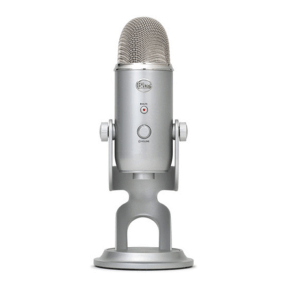


- Fantastic sound quality
- Sturdy metal body
- Plug-and-play
- Flimsy plastic knobs
California-based Blue Microphones have been around since 1995. They produce a variety of winter-themed professional microphones, headsets, and other audio gear. In this review, we’ll be focusing on their Yeti lineup, the first of which is a midrange model called Blue Yeti.
A good microphone for gaming has to sound good, be easy to set up, and filter out as much of the background noise, keyboard clatter, and other undesirable sounds as possible.
The Yeti comes with a full metal body (including the base, but not the knobs and thumbscrews) and features a simple softwareless, plug-and-play operation through a mini-USB port at the base. A 3.5 mm headphone jack can also be found at the base of the mic, providing real-time monitoring of your output through headphones.
The sturdy build and non-slip rubber pads on the bottom of the base ensure that, like the best microphones for gaming, once you put the Yeti down, it stays firmly in place. The base is also threaded, so you can place the mic on any standard or shock mount. You may want to do so, as the stand that the Yeti comes with is well-built but rather short.
The mic features a 16-bit, 48 kHz recording quality and sounds more than good enough for the needs of anyone streaming or podcasting. As with any versatile recording microphone, the Yeti features several polar patterns. The best mics for streaming usually offer a cardioid (front-focused) pickup pattern, but the Yeti also features bidirectional (front and back) and omnidirectional (picks up sound from all directions) patterns.
All modes are easily switchable through a knob on the same side of the mic as the gain control. In addition to these two, there is also a knob controlling the headphone volume and a dedicated mute button. These are also found on the body of the mic, sitting on the opposite side from the gain/pickup knobs.
Overall, the Blue Yeti is a great microphone for PC gaming and streaming. And even though there are more affordable models out there, the blend of price and performance available here makes it one of the best PC microphone options.
Razer Seiren Elite
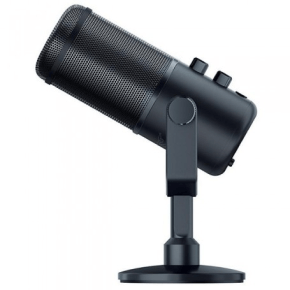
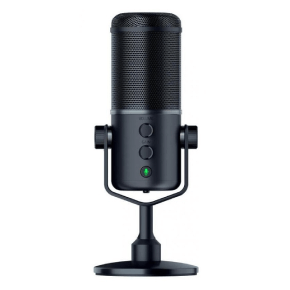

- High-quality sound for streaming
- Sturdy construction
- Handy high-pass filter
- Expensive
Formed in 2005, Razer made a name for itself with its gaming peripherals. While the company has sold gaming audio devices such as headsets and speakers in the past, the Seiren X and Elite models are the company’s first foray into professional mics for recording and streaming. In this review, we’ll be looking at the more expensive, $200 Seiren Elite. Those looking for the best cheap microphones for gaming should look elsewhere.
This is the company’s top-of-the-line model and part of the Broadcast range of streaming products. Unlike the condenser mics on our list, Razer ups the ante and goes for a single dynamic capsule, similar to the Shure SM7B. It also features a sturdy mic stand which allows for fine-tuning. Seiren Elite has headphone volume and gain knobs, as well as a mute button. And instead of a standard volume gauge, a red LED ring lights up when your signal starts peaking out.
With its 16 bit and 44.1 kHz or 48 kHz recording rates, this streaming mic produces quality sound. But audio geeks may lament the lack of 24bit recording, often found with top recording microphones at this price range or even cheaper. Furthermore, the high-pass filter and digital signal processing ensure that the mic can handle higher volume vocals and cut off background noises effectively. However, purists may be annoyed that they are not getting a pure, effect-free recording. Then there’s the fact that Seiren Elite features only one polar pattern - cardioid. This is perfect for solo streamers but not great if you plan on conducting interviews or having guests on your podcasts.
Remember, though, this is a Razer microphone. That means that while it offers amazing features as a streaming and podcasting mic, it’s not necessarily ideal for studio musicians. On the other hand, it’s a fantastic choice for Gamers looking for the best mic for Twitch.
Samson G-Track Pro
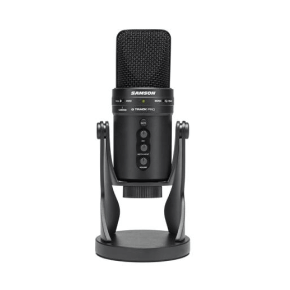


- Clean, high-quality sound
- ¼ inch audio input allows for 2-track recording
- Gain knobs for both inputs
- Lackluster design
The mythical hero’s strength lay in his hair. As for the company bearing his name, theirs is in high quality microphone solutions. The G-Track Pro is one of the best microphones on the market that stems from 30 years of experience and over a decade in creating USB-powered professional mic solutions.
Samson G-Track Pro is definitely a unique device. While most good streaming mics feature a headphone jack for sound monitoring, here, you’re also getting an entire dedicated audio input as a bonus. It comes with its own gain knob for three separate volume controls. There is also a mono/two-track recording button, a mute button, and a LED indicator for informing you when your signal is clipping or if the mic is muted.
With the option to plug in an additional microphone or instrument, this is a pretty capable audio interface and one of the best studio microphone options on our list. Just a heads up, though - both the mono and two-track recording options are effectively mono - the 2-track feature just allows you to record vocals and instruments (or another mic) on separate mono tracks.
But it still sounds fantastic. With 24 bit/96 kHz recording and a clean DSP-free signal, it’s a perfect recording mic for a variety of scenarios. It also offers three scalable pickup patterns (cardioid, bidirectional and omnidirectional).
The mic has a weighted desktop stand; however, there is no adapter for using the mic on standard non-desktop stands. Also, while the body construction is fairly solid, its wobbly knobs and buttons are definitely not the best USB microphone hardware you’ll find at this price. Those are small details compared to the wealth of fantastic features that this mic offers for under $130, though.
Blue Yeti Nano

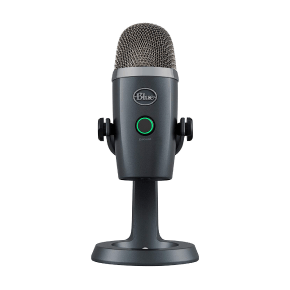
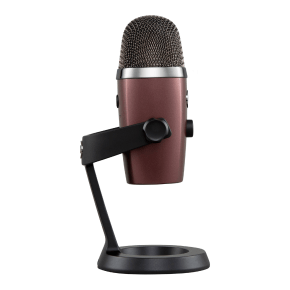
- Incredible sound at this price
- Very compact and light
- Compatible with a variety of stands and mounts
- No gain knob. Only two pickup patterns
The Blue Yeti model has always been widely regarded as one of the best condenser mic options on the market. Yet many wished for a more affordable and lighter version that didn’t compromise on sound quality. Blue’s answer is the Yeti Nano - a compact, beautiful-sounding mic that ups the original’s bitrate to a studio-level 24-bit while reducing its footprint significantly.
The Nano is nearly half as small as its older sibling. This is both a blessing and a curse - it’s one of the most portable dedicated gaming mics around. However, it’s less comfortable to use than the taller desktop mics such as the standard Yeti model. Blue had the foresight to include an adapter in the packaging, so if you find the stand is too short, there’s an easy fix.
But the size isn’t the only thing that got trimmed - the best microphones for gaming commentary feature dedicated knobs for gain control and multiple polar patterns. The original Yeti had both; however, the Nano features only a volume knob for headphone monitoring and two switchable patterns - cardioid and standard omnidirectional mode. There’s also a mute button and a LED ring that glows green when your signal peaks or red when you mute the mic.
We found the volume slider to be smoother than the one on its older sibling, so that’s another improvement to take note of. What hasn’t changed is the micro-USB connection port, found on the bottom of the mic’s body along with the headphone jack. All things considered, this may just be the best cheap USB microphone around.
Rode NT USB
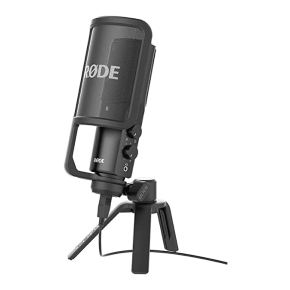


- Professional recording quality at an affordable price
- Excellent filtering of background noise
- Free pop shield
- Shaky tripod
Founded in 1967, Rode is one of the veterans on our list. With the NT-USB, the company set out to offer a studio-worthy recording performance for a price that matches most of its midrange competition. But is it really one of the best recording microphone options on the market, or is it just marketing hype?
Unlike a lot of the competition, such as Blue Yeti and Samson G-Track Pro, Rode opted for a single polar pattern - cardioid. This is the most commonly used pattern for gaming and accessing streaming platforms such as Twitch or Mixer.
The mic has two volume knobs, one functioning as a volume mixer/mic gain control and the other for the headphones that can be plugged into a standard 3.5 mm jack for monitoring purposes.
Meanwhile, the simple plug-and-play USB connection doesn't require any external software. It comes with a free detachable pop shield and has fantastic background noise filtering, making it one of the best gaming microphones for a noisy environment on our list. The package also includes a standard ring mount, a zip case, and a flimsy tripod stand.
Finally, let’s take a moment to talk about sound. While the rate looks disappointing on paper - 16 bit/48 kHz, the NT simply blows most of its competition out of the water when it comes to recording sound quality and clarity. In fact, short of the monstrous (and equally expensive) Shure SM7B, you won’t find a better or more accurate sounding mic anywhere near this price range.
In short, a phenomenal audio quality, combined with a free pop shield and excellent background noise filtering, makes the NT-USB one of the best desktop microphone options at this price range. If a cardioid recording is all you need, and you’re a musician or eSports streamer looking for a professional microphone for PC gaming, you should get one now.
Audio-Technica AT2020 USB+
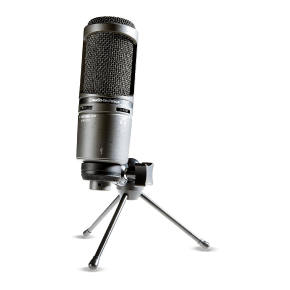
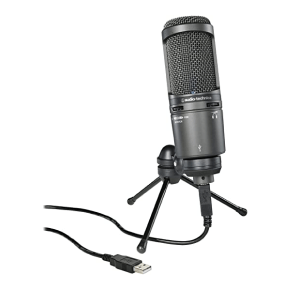
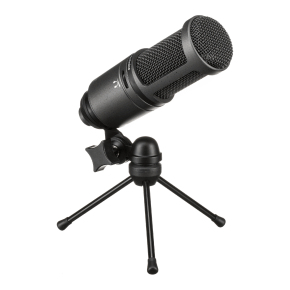
- Quality sound
- Tripod stand
- Zero-latency monitoring
- Only one polar pattern
Audio-Technica has been in the business since 1962, and the now venerable AT2020, their first foray into USB mics, has been around for over a decade. How does its latest iteration hold up against the top microphones for gaming in 2026, though?
As previously mentioned, this mic is an extension of an idea that has been around for quite some time. The original pre-2007 version it is based on was a well-loved XLR microphone. But the AT2020 has a great USB connection making it easier to be set up and allowing it to operate better. Despite the sound rates being only 16 bit/48 kHz, the sound quality still makes it a contender for the best gaming microphone of 2026. It is up there with the Shure SM7B - a step above what the likes of Blue Yeti or Razer Seiren can offer, as good as they are.
It does add a tiny bit of warmth and compression to the vocals, though. However, this effect only really flatters most vocalists, adding a little bit of extra body to the mid frequencies, mostly.
Being a mic aimed primarily at streamers, it comes with only one front-facing cardioid polar pattern. It may not be the best microphone for podcasting of group content, though. If you are looking for versatility or tend to invite a lot of people to your stream or podcast, there are better options out there. As a solo streamer, however, everything you’d need is here.
That includes a nice tripod stand that’s sturdier than it may appear but does require a bit of extra fiddling. Also, the background noise cancellation is not bad, but it’s not impressive either. The mic comes with knobs for controlling the gain and headphone input level, and no extra software is needed to get started - drivers will automatically be installed when plugging the mic in.
Overall, this is a fantastic device and one of the best microphones for gaming on the market. If recording sound quality is your primary concern, you can’t really do better at this price range.
Blue Yeti X
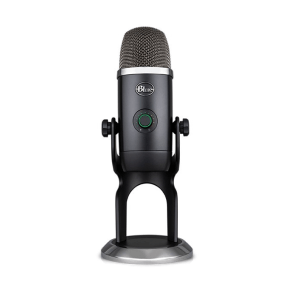
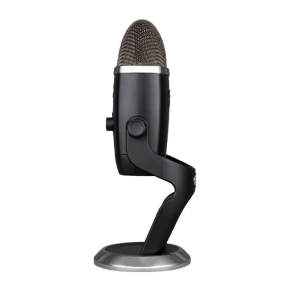
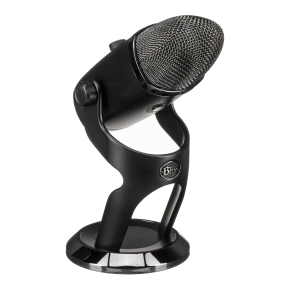
- Quality sound
- Blue Vo!ce software
- Sturdy design
- No USB-C Connection Type
The next product on our list is the perfect blend between Blue Yeti and the Blue Yeti Nano. But this mic is neither small nor cheap.
While it’s smaller than the original Yeti, it’s still bigger than Blue’s best cheap microphone on our list - the Nano. At around $170, it’s also nearly twice as expensive. But this is a versatile piece of gear that can record in cardioid, bidirectional, omnidirectional, and stereo modes. And unlike the original, the Nano’s 24-bit recording rate is here, along with a 48 kHz sample rate.
There’s also a four-condenser capsule array, whereas the original model had three and a LED indicator for the single multi-purpose button on the body of the mic. Pressing it mutes the mic while turning it controls both the headphone volume and gain, thus giving us back physical gain control, which was omitted on the Nano.
In the past, the Blue Yeti was often mentioned as the best microphone for streaming on Reddit and other similar communities. The reason was that back in its day, it didn’t have the kind of stiff competition it would if it came out today. One of the ways that the updated “X” version aims to differentiate itself on what’s become a competitive market is through the fantastic Blue Vo!ce recording software.
While certainly not mandatory to use, it does come with helpful effects and various presets for recording music or streaming on one of the popular platforms such as Mixer or Twitch. It won’t necessarily make it the best microphone for YouTube gaming around, but for those just starting out on a streaming platform, it does offer a quick and easy way to set up optimal recording conditions.
All in all, is the Yeti X worth it? That depends on your usage. Sure, it’s a fair bit more expensive than the other two Yeti models, but it is also a sublimation of some of their best traits while offering additional features on top of that. It might not be quite the slam dunk for Blue Microphones that the original Yeti was, but it’s still a great piece of gear and a solid contender for the best microphone for YouTube and other streaming platforms.
Shure SM7B
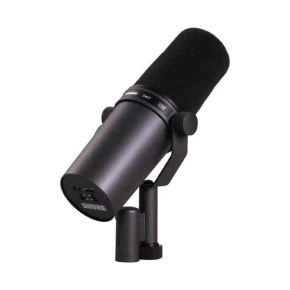
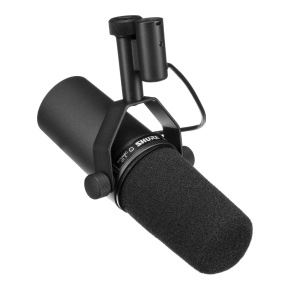

- Best sounding mic on our list
- Brand used by top artists
- Fantastic shock mount
- Very expensive
Any list consisting of the best microphones for gaming needs to include a Shure product.
The Chicago-based company has been in the biz for nearly 100 years, and that kind of experience translates to some of the industry’s best products.
But let’s get one thing out of the way first - this is the most expensive microphone on our list. Also, unlike the rest of the competition, it’s not a USB plug-and-play mic. If you’re looking for a simple and easy-to-install mic for PC gaming, you should skip SM7B. That’s not to say there is anything inherently complicated about this model, but XLR connections require a special cable and 48 v of phantom power, neither of which are provided in the box.
This is normal when it comes to audiophile equipment, as the best mics for recording tend to come with XLR connections and allow users to pick their own cables and recording equipment.
When compared to a typical streaming microphone, the SM7B is the only mic on our list besides Razer’s Seiren that features a dynamic instead of a condenser capsule. While this translates to a slightly lower frequency response and a sound that’s a bit less crisp, it does offer unparalleled sound clarity. Despite the 16-bit, 44.1 kHz rates, the sound quality in all registers is phenomenal. The rich bass and expressive treble are particularly good. The internal shock mount and included pop shield also ensure industry-leading performance when it comes to getting rid of unwanted noises.
Simply put - if you just need the best mic for Discord there are cheaper options that will do the trick. Even a gaming microphone on a headset will do. But if you have the cash, want the best noise-canceling, DSP-free, professional-quality mic, the SM7B is a no-brainer.
Zalman ZM-Mic1



- Phenomenal value
- Extremely light
- Super simple setup
- Poor design
After taking a look at the most expensive model, it’s time to review the cheapest one on our list of the best microphones for gaming. The Zalman ZM-Mic1 headphone microphone can hardly be considered anywhere near the quality of any of the fantastic microphones we’ve talked about, but at under seven bucks, it’s a phenomenal value and a clear upgrade over a typical headset mic.
One of the newer companies on our list, Zalman has been around for about twenty years. It was originally focused primarily on desktop cooling solutions but later expanded into audio territory as well.
The ZM-Mic1 is their solution to a common problem - a typical gamer just wants a good, clear-sounding mic, not necessarily the best mic for YouTube. They also don’t want to pay more for a gaming microphone without headphones than they would for a whole headset. So how does the ZM-Mic1 sound? Better than you’d expect for such a cheap device and good enough to rival a lot of mics on headsets costing up to $100. However, it is clearly in a different class. It’s also an omnidirectional-only mic - typical for budget 3.5mm jack microphones. That means that it WILL pick up sound from all over the room, and its noise isolation, especially compared to the top gaming microphones, is practically non-existent.
Still, the handy clips for your headphones of choice do mean that, compared to a typical mic on a desktop stand, your mouth is going to be close to the mic, minimizing background interference. But there is no option to clip the mic to your shirt. The attached cord is also very long, which can be a blessing or a curse, depending on how you plan to use it.
While this isn’t a serious contender compared to the other mics on our list, it’s the best sub-$10 microphone you can get. If you’re looking for the best cheap mic for gaming around, and your idea of cheap is under ten bucks, you really cannot go wrong with the ZM-Mic1.
Top 10 Microphones for Gaming in 2026
- HyperX Quadcast
- Blue Yeti
- Razer Seiren Elite
- Samson G-Track Pro
- Blue Yeti Nano
- Rode NT USB
- Blue Yeti X
- Audio-Technica 2020
- Shure SM7B
- Zalman ZM-Mic1
How We Picked The Best Gaming Mics: Evaluation Process
Choosing the best microphone for gaming is as important as finding the right gaming desk, a comfortable chair, and the set of top-notch speakers. However, there are tons of options, and prices vary wildly as well. Then there’s the technical lingo – what are condenser mics? How about dynamic ones? What is XLR and do I really need it? Polar patterns – are we talking about weather or mics here?! Most casual gamers and those who are just getting into eSports and streaming services can feel overwhelmed. Don’t worry, though, we’ve got you covered.
Our methodology explains some of the basic concepts such as microphone types, pickup patterns and USB/XLR connections. If you’re new to the world of professional mics give it a read – otherwise, you can check out our top picks and reviews here.
Sound Quality
When reviewing the best microphones for gaming, the first thing to look for is the quality of the sound recording. When discussing mics, it’s common to hear talk of pickup or polar patterns. The four most common options include cardioid, stereo, bidirectional and omnidirectional.
A cardioid microphone is usually the go-to choice for Twitch, Mixer, and YouTube streamers because it delivers a rich sound derived directly from the front of the mic, minimizing background noise and ambient sounds. Although some unwanted sounds, such as the clacking of mechanical keyboards, may still seep through, the best streaming microphones are able to filter out the majority of the background noise you don’t want in your recording.
Price and Value
As lovely as they are, not everyone can afford a professional gaming microphone, nor do most people really need one unless they are a professional streamer. Mics can cost anywhere from ten bucks to several hundred dollars, and you don’t always get what you pay for. A small cheap USB microphone is obviously not going to reproduce voice on the level of a studio quality microphone, but the idea here is to determine what gives the best bang for your buck, all things considered.
Type and Form Factor
Gaming microphones come in various shapes and sizes. When searching for the best gaming microphone, one of the first considerations is whether you need a dynamic or condenser microphone. The latter usually gives a warmer sound but requires a quiet working space with little to no background noise. There’s also the matter of whether you need a USB or XLR connection - the former being easier to use (no extra hardware or phantom power needed), the latter providing superior sound quality and reliability. Finally, the size itself and aesthetics are a consideration for many streamers.
Build Quality and Versatility
We gamers are a fickle lot. Everyone has a different gaming desk, and most people have different requirements and preferences when it comes to microphone placement. For a device to be considered the best mic for gaming, it has to sound good in a variety of scenarios. It needs to be adaptable to your surroundings and usage scenarios. This is why most gaming mics tend to feature several switchable polar patterns and have good sensitivity.
Another important thing to consider is how well-built the microphone is. What materials are used? How durable is the device?
Bonus Features
The final category in our review methodology takes into consideration whether the microphones reviewed come with any additional features or benefits, such as a mic stand/tripod, zero-latency monitoring, or on-mic volume controls. While a rich feature set by itself does not make for a good microphone for streaming or gaming, more often than not, extra accessories can make a mic perform better under a wider variety of usage conditions.
Frequently Asked Questions
FAQ
Yes. Most gaming mics tend to be condensers, as they tend to have a crisper sound. That being said, a dynamic mic is an even better option if you want to minimize background noise and filter out unwanted ambient sounds.
Anywhere between $50 and $200 typically. This really depends on what you’re after, and every best microphone for gaming offers something different. If you’re shopping for a gaming microphone on Amazon, solid choices include Rode NT USB, HyperX Quadcast, the Blue Yeti line of products, or the Samson G-Track Pro. Good brands will set you back from $90 for the cheapest models to around $160 for the most expensive ones, with Razer Seiren Elite and a few other dynamic mics costing $200 or over.
Our pick is Samson G-Track Pro or Rode NT USB. When talking about the best microphones for gaming, almost all models on our list are a valid option, depending on your needs. If we had to pick two, though, the mix of great performance, good price point, and a variety of useful features would elevate these two just above the rest of the pack. You can’t go wrong with any of our other choices either, though.
The mic should be 6-12 inches from your mouth, ideally. The closer it is, the better, within reason. You obviously don’t want to be eating your mic, but the closer it is to your mouth, the better it will be able to pick up your vocal nuances, and the less ambient noise and background interference will get in the way of your recording or stream.
Your email address will not be published.
![$row['title'] - image](https://trinity-core-s3.s3.us-west-1.amazonaws.com/kommandotech/1250/HyperX-Quadcast-1.png)
![$row['title'] - image](https://trinity-core-s3.s3.us-west-1.amazonaws.com/kommandotech/1252/Blue-Yeti-1.png)
![$row['title'] - image](https://trinity-core-s3.s3.us-west-1.amazonaws.com/kommandotech/1253/Razer-Seiren-Elite-1.png)
![$row['title'] - image](https://trinity-core-s3.s3.us-west-1.amazonaws.com/kommandotech/1254/Samson-G-Track-Pro-1.png)
![$row['title'] - image](https://trinity-core-s3.s3.us-west-1.amazonaws.com/kommandotech/1255/Blue-Yeti-Nano-1.png)
![$row['title'] - image](https://trinity-core-s3.s3.us-west-1.amazonaws.com/kommandotech/1256/Rode-NT-USB-1.png)
![$row['title'] - image](https://trinity-core-s3.s3.us-west-1.amazonaws.com/kommandotech/1257/Audio-Technica-AT2020-USB%2B-1.png)
![$row['title'] - image](https://trinity-core-s3.s3.us-west-1.amazonaws.com/kommandotech/1258/Blue-Yeti-X-1.png)
![$row['title'] - image](https://trinity-core-s3.s3.us-west-1.amazonaws.com/kommandotech/1259/Shure-SM7B-1.png)
![$row['title'] - image](https://trinity-core-s3.s3.us-west-1.amazonaws.com/kommandotech/1260/Zalman-ZM-Mic1--1.png)


